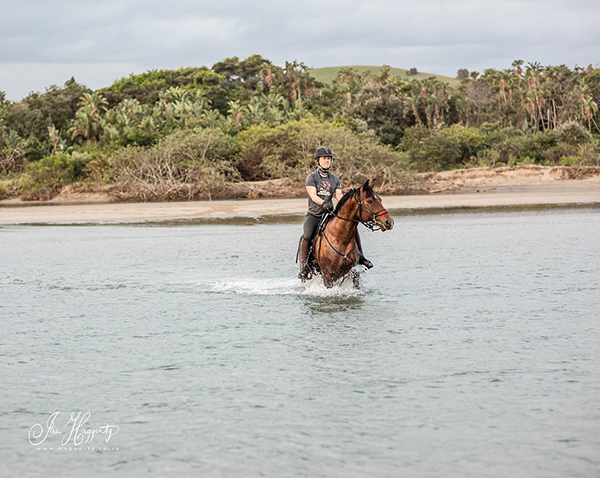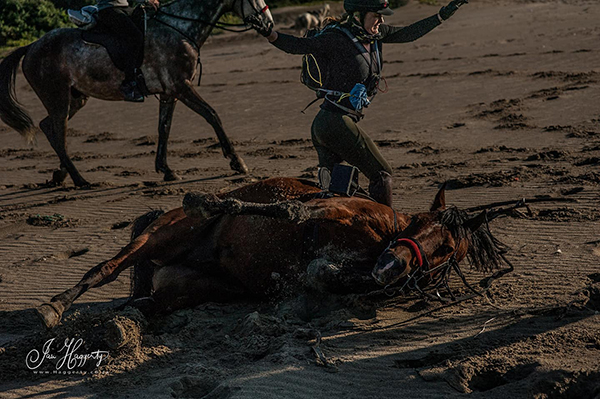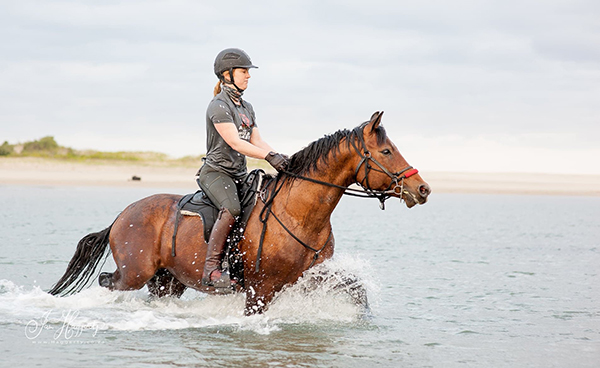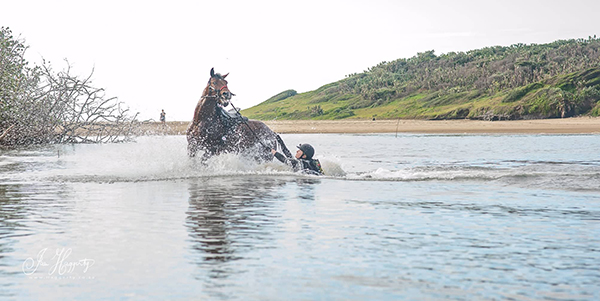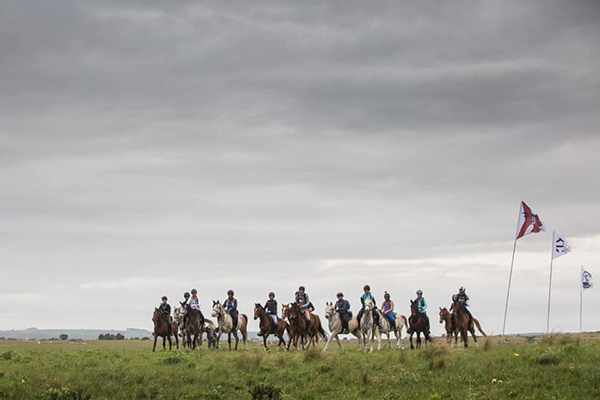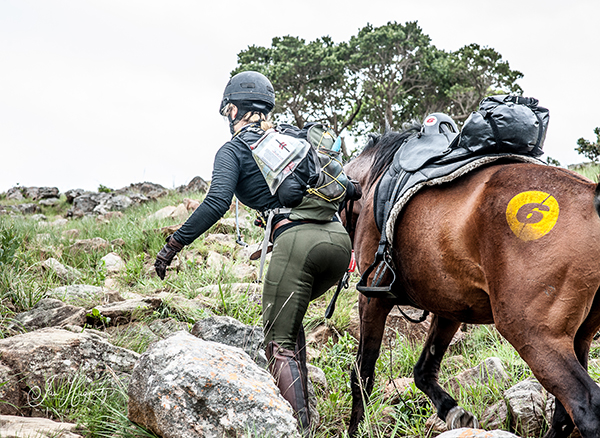Race the Wild Coast 2018-Part 2
By Katy Willings. Read Part 1 & Part 3 of this series.
Equestrian adventurer and endurance rider, Katy Willings shares her wild ride with Race the Wild Coast, a 350-kilometer endurance race on horseback along the eastern seaboard of South Africa, from Port Edward to Kei Mouth.
Swim training and horse orientation
During the briefings, we drew for our first horses. I drew the exotic-sounding Zerango and during a lull in briefings, all the riders dashed outside to see which horse in the paddock had their number on. Mine, when I found him, wasn’t in the paddock at all, but a corral all of his own--a stallion! He looked pretty unimpressed with the human he had drawn, and in fact, Wiesman, who owned and prepared all of the horses for this adventure, had to persuade him to stand still and be caught so I could get a hand to him. So that was a good start.
Zerango, the beautiful Joker. Photo courtesy Ian Haggerty.
Civilities aside, it was clear that he was a superb horse; big fronted, uphill, alert, muscular, covered in the scuffs and scrapes that proper stallions tend to be. Wiesman himself had ridden a 50 km race on the horse a couple of weeks earlier. “He’s a character, but he’s worth it”. My experience with the very wild horses of Mongolia (I rode the inaugural Mongol Derby in 2009 and have organized all the subsequent ones for The Adventurists), had taught me not to seek affection or approval from horses, especially on a first meeting. Simply co-exist and get your point across quietly and clearly--and establish a way of working together. Hopefully, bonds of loyalty and warmth can follow. He was not my pet, but my team-mate. I immediately saw his independence as a strength; he had much more idea about how to navigate this crazy race than I did, and I would be trusting his opinion about what was safe far more than my own.
The first ride involved a rude awakening almost immediately, as we rode off at five-minute intervals to a lagoon for a practice paddle. After 50 meters we turned into the dense forest, and what looked to me like an impassable trail. “You must decide whether to ride or get off”, Barry had said, somewhat enigmatically. Was this a test? Had I failed it already? Well no-one else had turned back, so I slipped Zerango some rein and nudged him forwards, upwards, and sideways, simultaneously; basically he had to decide for himself how to ascend a twisty, rock-strewn, creeper threaded cliff, in the half-light, with his rider ducked low to get under a series of boughs that could wipe you clean off the horse, muttering things like “ooh, careful there, well done, that’s good, you clever thing, whoops there, duck again”.
Again, I imagine he felt some relief that none of his herd mates were in earshot while his rider 'grew a pair' and got her eye in for what would become our absolute bread and butter over the next 72 hours. Coming up for air and daylight at the top of the ridge, then riding down to the water’s edge, I felt a genuine elation and wellspring of appreciation for the horse and what he could do. At that point I had no idea that this really was the elementary class for Racing the Wild Coast, and am so glad I kept my “well crumbs, that was pretty crazy!” comments to myself on catching up with my fellow competitors on the shore. It got so, so much tougher.
Zerango enjoying a good roll, regardless of his rider. Photo courtesy Ian Haggerty.
Our first swim was more of a wade, and so on training Day Two, we were instructed to be saddled and mounted at 6:00 am to ride out as a pack for a proper swim session, supervised by the brilliant crew riders who had been prepping the horses for many weeks for the event. As we arrived at the beach for a quick briefing as a herd, Zerango stretched down to scratch his nose. And then continued on to have a proper roll, causing me to leap acrobatically out the side door before he rolled on me. Well played, horse. We were definitely the jokers in the pack, for better or worse.
Wiesman brought one of the greener spare horses along and rode him on a halter with a rein around the horse’s chest for steering, a memorable lesson in how unnecessary and surplus all of that tack is if you are genuinely gifted as a rider. He rode it into the crashing waves without ceremony or hesitation, as the Rocketeers were busy persuading their mounts to get a single hoof wet and cope with the extraordinary dizzying sensation of riding a straight line along a lapping tidal beach.
Zerango. Photo courtesy Ian Haggerty.
We cantered through the surf as a pack and it was here that my horse showed me what he could do. He was beautifully balanced, fantastically independent, happy to go at his own pace, and could out-trot most of the other horses at a canter--the most fabulous horse to sit on. All was forgiven. We had to cross a river to get home again, so the group gingerly pushed off from the far bank with Barry’s instructions ringing in our ears. Get the horse to swim a couple of strokes before slipping off to the side and hooking the right arm over the saddle to keep you together. You might need to steer, they may want to turn, but in general, stay off the bridle so that their head stays up and out of the water. Their nostrils are at the bottom, don’t forget...
What he didn’t brief us on was what happens as they exit the water. What happened to me had a huge bearing on the rest of my race. Zerango swam confidently, and was on his feet swiftly, as I was still waterborne and hanging off his bridle and the pommel of the saddle. He started to tow me ashore, pulling me further off my feet and putting more pressure on his head as I fought to hold on to him (don’t ever let this horse go, had been the advice of NC--who had done his training rides). He literally heaved me ashore like a deep sea fish, hanging on to him with one arm. I thought he had pulled my shoulder clean out of its socket. Well, he didn’t, but there were a distinct ripping sound and sensation, and a burning, shooting pain running up and down my arm as soon as the initial adrenaline rush wore off and we were back to base camp.
Katy getting her shoulder pulled out of its socket. Ouch! Photo courtesy Ian Haggerty.
So that was quite enough training!
Patched up and ready for battle - don’t look like shark bait
We had the rest of the day, and all night, to make final preparations, and in my case, stew over whether I was even fit to start. In a competition like this, showing the damage to your compatriots and rivals makes you a liability. With the best will in the world, no one will want to ride with the sick one, it’s like swimming in shark infested waters with a bloodied steak tied round your neck. You don’t want to be the slowest, and you sure as hell don’t want to be stuck nannying them. So, I spent most of that day on my own, and politely out of reach of the field except at the veterinary and technical briefings--just monitoring my own pain and seeing what a series of anti-inflammatories did. A limited amount.
The start of Race the Wild Coast. Photo courtesy Katy Willings.
We officially vetted the horses in at around 4:00 PM, their numbers spray-painted onto their quarters and a nice first trot up before we all got too wet and dirty. I mentioned to a couple of the crew, Alex, and Nicola, about the shoulder and how I had done it in swim training. These two ladies saved me that evening. Alex, a fellow Mongol Derby veteran, and fellow “push through the pain” kind of girl, and a world class horsewoman in her own right, taped my shoulder with the skill of someone who has a lot of practice artificially supporting major joints. This allowed me a much greater range of motion with confidence - the tape would take some of the strain at the limit.
Meanwhile, Nicky and I discussed swim tactics. If the same thing happened again, I’d be toast, and we had no less than 32 rivers to cross in order to finish the race. Many of these would be a swim. Rather than sliding off to the side and having to get to my feet at all, Nicky told me to try swimming directly above the horse and wriggling back onto the saddle just as he started to walk, rather than swim. Effectively, let the horse catch you again before exiting the water. We had no opportunity to practice this, but it sounded simple enough. Lastly, she slipped me a more ‘traditional’ form of pain relief and told me to turn in and sleep on it. I devoured the hash cake with the relief of someone who knows that their mum was not watching and hunkered down in the sleeping bag.
The hike to the starting line. Photo courtesy Ian Haggerty.
I don’t know for sure but as we hiked up to the start line 12 hours later, I think we looked, to the rest of the field at least, like contenders, not shark bait. We very quickly had far more important things to think about.
And we’re off!
Day One: Control your kit, control your fear. The horses will help
The first day involved 75 km broken into two stages. Everyone had to get to the compulsory overnight stop, so the spread of the field would be controlled only by our departure times the following morning, for our third and final stage with our first horses.
The reality was a lot less tidy than this. For most of the day, the overnight stop felt like another planet, a whole dimension away. There seemed to be no end to the hazards in between. It was genuine shellshock to be out and racing across terrain so rugged and remote, and 75 km meant very little indeed, almost immediately. Within 5 km of the start, I'd already had my cantle bag, containing my sleeping bag, work itself loose and bounce around intolerably on Zerango’s bottom, forcing me to dismount and try and re-secure it to the back of the saddle while the rest of the field streamed past us. A couple of incredibly generous riders, Chetta and Courtney, offered to wait with me, and Chetta even gave me a bungee cord to help secure the bag. I could tell that it would be an involved procedure to re-fit the saddle bag and decided to hold it for now and perhaps re-fit it at the first vet check. After all, we had mainly beach to navigate for the next 20 km. Easy!
As I levered back into the saddle, we saw another rider, Melissa, hit the ground. Her horse then streamed past. She was bleeding from the face and had also hurt her wrist badly in the fall, but was determined to ride on, and we helped her catch her horse and remount. From there we continued that day as a team of four, out the back but decidedly safe there and determined to work as a team to overcome any other ensuing dramas. I hadn’t committed pre-race to ride with anyone, and I hadn’t ruled it out either, but these two episodes in quick succession made me want to join forces. It seemed likely on this event that everyone would need a rescue at some stage.
Day One of Race the Wild Coast. Photo courtesy Katy Willings.
The great stretch of beach we finally emerged onto after the treacherous tangle of the forest gave us a great opportunity to get some speed up, see what our mounts could do, and what their strengths were. Before the first big swim, we agreed to all get off and make any kit adjustments, take a pee, or take any painkillers, as required. Having cantered down the beach holding my cantle bag like it was a picnic basket, I took the opportunity to reattach it with Zerango parked next to a nice tall rock to give me some leverage. We were back within sight of the leading pack at this point but decided to keep our pod of four and stay out of the salmon run up front; both Melissa and I were slow to mount and dismount, for good reason, and we couldn’t risk further rough and tumble type injuries.
However, plenty of 'rough and tumble' was available without reference to other horses and riders. We frequently descended treacherous cliffs to get down to the beaches. The rivers were also a big challenge. Even on the flats, the heavy rain on the first two days of the race meant that there was very little easy going; tracks were hopelessly slippery, the light was extremely poor, and sand was as likely to be sucking and draining. This meant we were traveling a good deal slower than the riders had in 2016, especially on Day One. Having launched the race at 10:00 AM, we only left the first vet check at around 3.30 PM, with less than three hours of daylight remaining. Little did we know, and little did the organizers intend, but we’d be doing half this leg in the dark.
The first vet check was a rude awakening in how quickly 40 minutes disappears. Wiesman and other crew were there and they took the lead on feeding and watering the horses. My boy needed his own pen again, which made my job a little harder - other riders could take it in turns watching the horses while others fetched water, made running repairs, got food, checked the route for the next leg, etc. Wiesman was generous in babysitting my horse awhile so I could sort my saddle bag, once and for all. I think I rammed a cereal bar down but that really was all I had time for before we set off again. Zerango had eaten up, peed and drunk a little, though he had done all that and more out on the trail too, so I had no concerns about his metabolic state. He really was the healthiest and most vigorous of horses.
For around 90 minutes we enjoyed great positive progress, and a solid team dynamic. Chetta’s horse was ultra-reliable and would be first to go down the stone staircases or into deep water. Courtney was an absolute wizard with the GPS--and Melissa was hanging in there. I think we all got something positive from seeing her unbelievable stoicism and felt committed to getting her home, but her horse was fast and athletic and helped keep our cruising speed up; and I had Zerango, such a natural leader, who set the pace all day, and, as it turned out, into the night…
Riding in last through the dark. Photo courtesy Daniela Zondagh.
It was incredibly demoralizing to ride through the dying light, barely counting down the kilometers and knowing things would get much worse before they got better. We lost the trail a number of times in the dark, and I found my headtorch only illuminated the rain slashing in at us. I used a handheld torch as well, but this spooked the horses constantly and was equally frustrating. Using the backlit GPS made us almost seasick once we had lost visual reference with the ground, the sky and everything else.
We were hopping on and off the horses constantly trying to edge gingerly towards “the racing line” and see what it was pointing us up or down. I knew at this point that we would survive the night--it wasn’t really a big drama, but I really did feel there was little point continuing. We may as well drop anchor, stand around in this muddy puddle until dawn broke and try again. I was too tired to even be cross about it, though at various points I did envision my next conversation with Barry, the race director--it was going to be terse, no mistake. After what felt like hours of night riding, we were finally spat out onto hard sand, with just a lagoon to cross and 500 meters to the overnight stop, Mbotke.
The swim held little terror for us, since we could not have been any wetter anyway, and could not see the bottom, the shore, or anything else to tell us if it was a good or bad idea. Zerango swam confidently and we unsaddled at the vet check under floodlights. We had a couple of cuts and scratches which would need a second check in the morning, but all was well--miraculously. The camp consisted of the same sturdy tents we had occupied at start camp, and I broke out the ultra lightweight sleeping bag which was dry, but hardly insulated.
As I came to realize on the race, the quality of sleep you experience during an ultra-endurance event like this is different. I think I would have slept on a bed of nails that night. I just blacked out, every night, until the cold crept in or the alarm went off. We had established a very powerful bond of trust with the horses, who had gotten us over, under, and through some unspeakable terrain and conditions, and with each other, and, in my own case, with myself. I really was quite hard to kill! If I could just get my act together and tie all my equipment on properly, I’d be laughing.
Continue reading Part 3 of Race the Wild Coast
About the Author: Katy Willings was the Mongol Derby Chief from 2011-2018 and erstwhile Chief of Adventures at The Adventurists. Based in Bristol, UK, she was a junior international dressage rider in her teens. She rode in the inaugural Mongol Derby, the world's longest horse race, in 2009, sparking a later endurance riding career which saw her compete up to 120 km internationally, and became a full-time Adventurist in 2010, working on the Derby, and later the Ice Run, Icarus Trophy, and Monkey Run. In the course of producing high profile events for the Adventurists, she has ridden vintage Russian motorcycles in sub-zero temperatures, wrangled with customs in far-flung places, managed local and international teams to deliver logistically complex and culturally significant goods and services--and even learned to fly a paramotor. Kind of. She finally did her motorcycle test in May 2018 and took to the open road, legally, this summer. She has worked with horses in Europe, led horse treks and safaris in Mongolia and Malawi, and men and machines in Morocco, Siberia, and Sierra Leone. She has had as much adventure putting on the adventures, as the participants have had taking part. Oftentimes, a great deal more. She laughs in the face of people doing only two things at once.
She runs beautiful riding adventures in Mongolia, her spiritual home, from her bespoke offering, Morindoo Tours. Follow along with her adventures on Instagram and Twitter.
